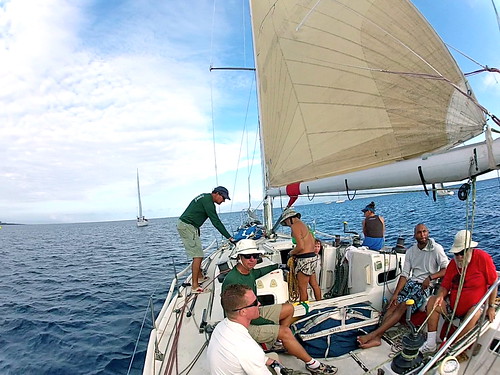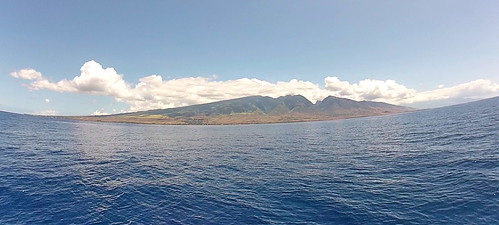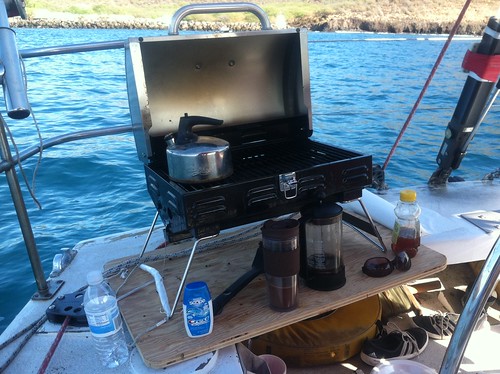
SCUBA Diving in Oahu with Kaimana Divers Honolulu, Hawaii (Me with the yellow flippers)
My dive buddies and I made sure to reserve our spots on the boat Nacho a few days in advance! We opted for the morning departure, which caters to more experienced divers and offers the advantage of calmer waters and less wind. The boat runs twice daily for a two-tank dive trip, making it easy to plan your adventure. We were conveniently picked up at our hotel in Waikiki and dropped off at the boat in Kewalo Basin, Oahu. Tanks and weights are included in the cost, with additional gear available for rent if needed.

Our adventure began with a short but exhilarating 10-minute boat ride to our first dive site: The Seatiger. As we cruised over the calm morning waters, the anticipation among the divers was palpable. The Seatiger, a 168-foot Chinese merchant ship, rests on the ocean floor as an artificial reef—a project initiated in 1999 by a local company to enhance marine habitats. Today, this sunken vessel is a thriving underwater ecosystem and a must-see dive site in Oahu.
As we approached The Seatiger, the crew gathered us for a thorough debriefing. The dive master painted a vivid picture of what awaited us below. The ship lies at a depth of about 120 feet at its deepest point, with the deck sitting around 90 feet. This depth means the site is best suited for advanced divers, and the morning’s calmer conditions made it an ideal time to explore.

We were briefed on the layout of the wreck, with its towering superstructure and open cargo holds, offering a mix of narrow swim-throughs and expansive areas to explore. The dive master highlighted key points of interest, such as the wheelhouse and the ship’s stern, where marine life tends to congregate.
Gear-up, wetsuit on, and jump in the water. The water temp in summer is around 79 degrees fahrenheit.

The visibility is not great today due to Hurricane Julio (2014) passing the islands about 2 days ago. We had about 60 feet of visibility in areas.

We follow the mooring line down 100 feet to the bow of the boat. The boat bottom rest at 120 feet.

As I got closer to the bow of the Seatiger on my descent, I saw two massive Green sea turtles resting next to each other.

As for what we might encounter, the possibilities were thrilling. The Seatiger is home to an array of vibrant marine life. Schools of colorful fish, including yellow tangs and butterflyfish, are common sights, darting in and out of the ship’s nooks and crannies. Larger residents like moray eels, octopuses, and even white-tip reef sharks are often spotted around the wreck. The dive master also mentioned the potential to see Hawaiian green sea turtles, gracefully gliding by or resting on the deck.
Hawaiian name for turtle: Honu

Everything underwater deserves our kindness and respect. As divers, it’s crucial that we stay mindful of our surroundings and avoid touching anything during our dive. Marine life, including turtles and coral, should be left undisturbed. Coral, in particular, is delicate—while it may seem sturdy, it’s easily damaged. Touching it can break its protective mucous layer, allowing bacteria and other harmful substances to penetrate and potentially kill the coral. By keeping our distance, we help preserve the fragile ecosystem that makes diving so special.

It's taken many years of SCUBA diving to achieve perfect buoyancy. Keeping neutral buoyancy while scuba diving is key to less Co2 consumption, safety of reef and others. Fine-tuning your weights and controlling your breathing are important factors to maintaining neutral buoyancy or less buoyancy shift with depth.

Dropping down into a 'cavern' (penetration inside the target venue) on the shipwreck with no lead line. No line was needed since we were only going one layer deep. If multi layer penetration, always use a line so you do not get lost in the venue.

Please note: Do not enter a shipwreck unless you have been properly trained in technical, full-penetration wreck diving.

My dive buddy taking amazing photos of our adventure. I jumped out the window to see some fish!

Two eels hanging out next to each other. The highlight of the dive! I've never seen two eels in the same hole.

Too many divers. We upset the marine life.

Our second dive was at MarioLand. The GoPro died. Ops! Need to charge the battery for tomorrows diving with Lisa!
DAY TWO - SCUBA Diving with Lisa - Afternoon diving
MarioLand, located off the coast of Oahu, is a dive site that truly lives up to its playful name. This underwater paradise is known for its vibrant marine life and intriguing rock formations that make every dive feel like an adventure through an aquatic playground.

Afternoon diving is less advance, shallow diving. I really like the dive masters at Kaimana Divers and their equipment is new! Lisa, who use to live in Oahu, got us a Kamaʻaina rate.
One of the highlights of diving at MarioLand is the chance to encounter some of the more elusive residents, such as octopuses and moray eels, hiding within the crevices of the rocks. The site also offers the possibility of spotting larger pelagic species, like reef sharks or even the occasional eagle ray, gracefully passing by.
The visibility at MarioLand is usually excellent, allowing divers to fully appreciate the beauty of the underwater world. The relatively shallow depths make it accessible to divers of all experience levels, while the varied terrain provides plenty of opportunities for exploration and discovery.

Drop down to 50 feet to a reef, Lisa and I are enjoying the small reef life.

Green Turtle at a cleaning station. Cleaner fish are fish that provide a service to other fish species by removing dead skin and ectoparasites. It's like a spa for fish!
The topography of MarioLand is what makes it particularly special. The site features a series of large lava rock formations that create swim-throughs, arches, and small caves. These structures not only provide shelter for marine life but also add an element of excitement as you navigate through them. The rocky outcrops are adorned with coral and sponges, adding splashes of color to the otherwise rugged landscape.

Four dives total in two days. I would have liked to see more and get in more diving, but the conditions were not great due to the passing hurricane.
Diving at MarioLand is an unforgettable experience that captures the essence of what makes Oahu’s underwater world so unique. Whether you’re swimming through the arches or marveling at the marine life, this site offers a magical glimpse into the wonders of the ocean.









































